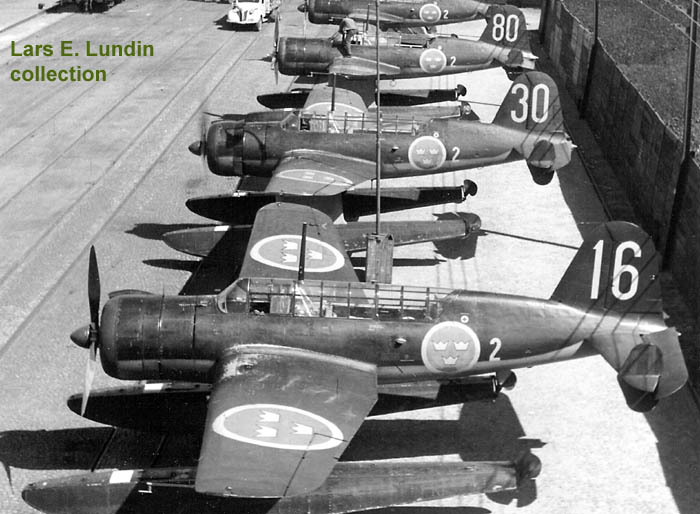|
|
||
|
S 17BL & S 17BS - SAAB S 17 (1942-1952) |
||
| Page 1 (3) |
|
|
|
|
||
 |
||
|
The
SAAB 17 was originally intended as a reconnaissance aircraft, although
it is most known as a dive bomber. It was the first modern monoplane in
light metal shell construction both designed and built in Sweden. (See
also B 17 in the chapter
”Bombers”).
The
contract for two prototypes of the new aircraft was signed in the end of
1938 between the Air Board and ASJA, a predecessor to SAAB. The aircraft
flew for the first time in May 1940. The trials resulted in a lot of
improvements of the design.
SAAB
17 as a reconnaissance aircraft was ordered in two versions. 21
aircraft, S 17BL (”L” =
Land), were built primarily for co-operation with the Army. They were
delivered to the Air Force in 1942. The S 17BL succeeded the Fokker
C.V-D/C.V-E (S 6), a now very
obsolete biplane from the end of the twenties. 38 aircraft of the S 17BS variant (the last ”S” = Sjö = Sea), were to succeed the
old ”Hansa” (S 5) for
naval reconnaissance, and were fitted with floats. These were also
delivered in 1942. Totally 322 SAAB 17 of five different versions were
manufactured.
All
SAAB 17s had a crew of two placed under a long canopy. One observing
window and one camera hatch were arranged on each side of the floor in
the reconnaissance variants. The marine version S 17BS was equipped with
a P.R. camera type N2.
The
aircraft was armed with three 7,9 mm machine-guns - one at flexible
mounting behind the observer and two fixed in the wings.
The
S 17BL was painted according to the then existing Air Force standard.
The upper side was olive green and the underside light blue-grey. The
naval version S 17BS was initially painted in a dark grey-green colour
- ”submarine paint” instead of the olive green.
The
lack of suitable engines for the SAAB 17 was a great problem. 550 Pratt
& Whitney ”Twin Wasp” engines had been ordered from USA together
with the great order of 316
combat aircraft from American manufacturers. Due to the outbreak of
WWII, only 62 aircraft reached Sweden and the delivery of engines and
other aircraft equipment was interrupted. Moreover, license production
of engines were denied by the USA due to export restrictions. Luckily,
the SFA (Svenska Flygmotor AB) managed to copy the ”Twin Wasp”,
which were to power the ”A”-versions of the SAAB 17 bomber. But for
the less demanding reconnaissance aircraft, the Bristol Mercury XXIV
9-cylinder radial engine of 980 hp had to do. This engine was also
manufactured under license by SFA.
To
get a maximum of tenacity of the wing, it lacked recesses for the
landing gears. The gears of S 17BL were folded backward-upward and were
covered by stream-lined cowlings. The landing gear with wheels could be
replaced with a retractable ski gear. The floats of the S 17BS were
fitted with water rudders. S
17BL - Length: 9,8
m. Span 13,7 m. MTOW 3790 kg. Max. speed 395 km/h.
S
17BS
- Length: 10,0 m. Span 13,7 m. MTOW 4.000 kg. Max. speed 345 km/h. Photos of S 17BSs of the naval flying Wing F 2 near Stockholm.
|
||
|
For the Model Builder |
||
 |
||
|
|
||
|
|
|
|
|
||
| © Lars Henriksson |
|
Updated 2010-07-17 |
|
Custom Search
|
||
